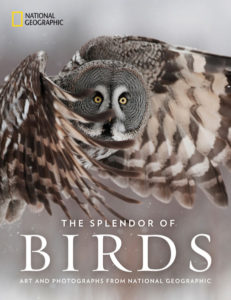 Regular readers will know that I don’t hold much truck with large-scale book promotions. The books cited and featured in The Well-read Naturalist are selected based upon how much merit I find in them and how interesting I think they will be to my readers. However every so often I receive a message from a publicist promoting a book that also happens to align with my usual editorial standards, the result being that said book is determined to be worthy of inclusion here. Such was the case most recently with a message from Trish of TLC Book Tours regarding The Splendor of Birds from National Geographic.
Regular readers will know that I don’t hold much truck with large-scale book promotions. The books cited and featured in The Well-read Naturalist are selected based upon how much merit I find in them and how interesting I think they will be to my readers. However every so often I receive a message from a publicist promoting a book that also happens to align with my usual editorial standards, the result being that said book is determined to be worthy of inclusion here. Such was the case most recently with a message from Trish of TLC Book Tours regarding The Splendor of Birds from National Geographic.
Taking the form of a large-format plate book, The Splendor of Birds presents a collection of some of the finest ornithological artwork and photography from the National Geographic archives. Spanning a 130 year range, beginning in 1888 and moving forward chronologically up to the present, the images included present a remarkably varied assortment of photographic styles and subject focus areas, as well as some truly choice illustrations, most notably by the great Louis Agassiz Fuertes.
Divided into four chronologically delineated chapters, The Splendor of Birds allows the reader – viewer, actually, as while there are short essays included it’s really the imagery that forms the raison d’être of the book – to explore the development of ornithological imagery as collected by the photographers and artists of National Geographic.
While many will likely find themselves most readily drawn to the final chapter’s astonishingly vibrant and crystal clear detail in such photographs as Bertie Gregory’s 2014 intimate portrait of a Great-crested Grebe with chick, or Anand Varma’s mind-blowing 2017 image of an Anna’s Hummingbird with extended tongue that defies description and must be seen to be understood, my own attention was captured and held by the more simple and subtle images collected in the first chapter.
Spanning the years 1888 to 1939, chapter one presents not only such sublime illustrations as Fuertes’ European Starling and his Tree Swallow, but also such expansive black and white documentary photographs as a flock of Dovekies off the coast of Greenland with square-rigged ships in the background (Underwood and Underwood, 1909) as well as meditative, casual images as the 1914 one from New Hampshire of a snowshoeing woman quietly contemplating a small flock of White-winged Crossbills feeding on the snow-covered ground (photographer unknown).
These are the type of images that give me pause; that cause me to stop and muse over them – not so much in wonder at how they were created (as is so often the case with the high-tech wizardry used to create images today) but about their implications. What is the current conservation status of Dovekie off the case of Greenland? How would the same area appear today should I have the opportunity to venture there? And about those crossbills – they’re irruptive. Was that a significant year for their population in the area? What is their status there at present? And what what it like to snowshoe through the New Hampshire fields in the nineteen-teens? How still it must have been!
The Splendor of Birds is the sort of book that would make a splendid gift for any gift-exchanging holiday, or perhaps in honor of the birthday of someone you particularly like. I think it’s safe to state that it would be most heartily welcomed indeed by most any bird watcher, regardless of their level of interest or expertise in the activity, for the images it presents require no previous understanding of the birds depicted; all that is required is the willingness to sit, peruse, and surrender oneself to a possibility of unbridled wonder.
If you enjoyed reading this, please consider signing up for The Well-read Naturalist's newsletter. You'll receive a helpful list of recently published reviews, short essays, and notes about books in your e-mail inbox once each fortnight.
